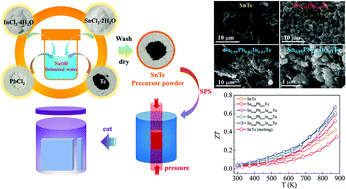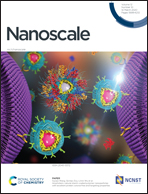Thermoelectric performance of nanostructured In/Pb codoped SnTe with band convergence and resonant level prepared via a green and facile hydrothermal method†
Abstract
SnTe is considered as a promising alternative to the conventional high-performance thermoelectric material PbTe, which inspired the thermoelectric community for a while. Here, we design a green, facile and low-energy-intensity hydrothermal route without involving any toxic or unstable chemicals to fabricate SnTe-based thermoelectric materials. Ultralow lattice thermal conductivity and enhanced thermoelectric performance are achieved via the combination of band engineering and nanostructuring. Enhanced Seebeck coefficient and power factor are induced by converging the band structure and creating resonant levels due to Pb and In doping. More importantly, due to the reduced grain sizes, nanoparticles, and dual-atom point defect scattering, ultralow lattice thermal conductivity was obtained in the bulk samples fabricated by the hydrothermal route. Benefiting from the enhanced power factor and significantly reduced thermal conductivity, the peak ZT is enhanced to ∼0.7 in In/Pb codoped SnTe, a 60% improvement over pure SnTe.

- This article is part of the themed collection: Editor’s Choice: Thermoelectric nanostructures


 Please wait while we load your content...
Please wait while we load your content...